Circular Economy: Key Concepts, Barriers, and Successful Business Examples
VerifiedAdded on 2023/06/16
|13
|3569
|466
AI Summary
This report discusses the key concepts behind the circular economy, including its focus on recycling and regenerating value. It also explores the barriers that businesses face when transitioning to the circular economy, such as financial, structural, operational, attitudinal, technological, and legal challenges. Additionally, the report provides examples of successful businesses that have implemented the circular economy and analyzes how they have managed to do it. Overall, the report highlights the benefits of the circular economy, including reduced waste and improved sustainability.
Contribute Materials
Your contribution can guide someone’s learning journey. Share your
documents today.
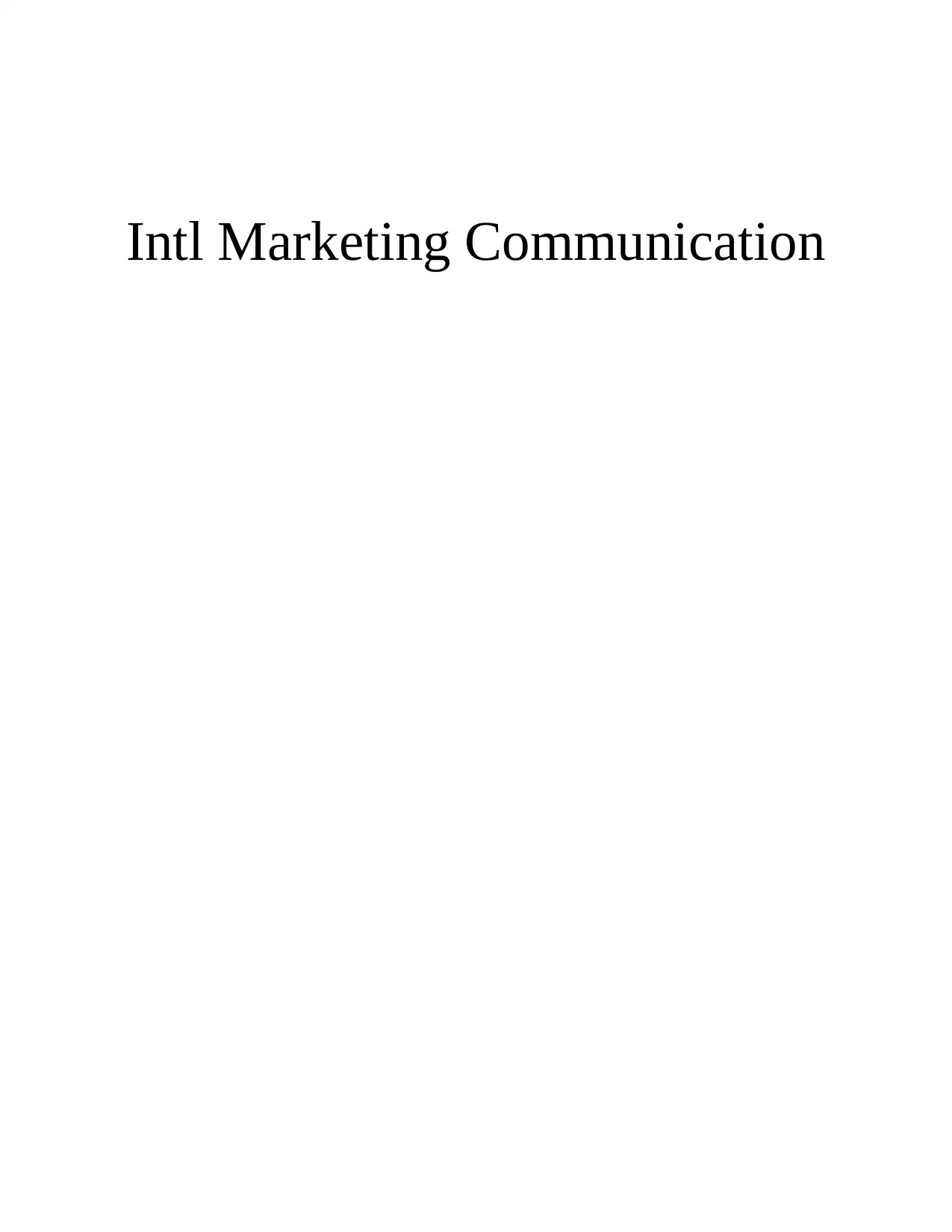
Intl Marketing Communication
Secure Best Marks with AI Grader
Need help grading? Try our AI Grader for instant feedback on your assignments.
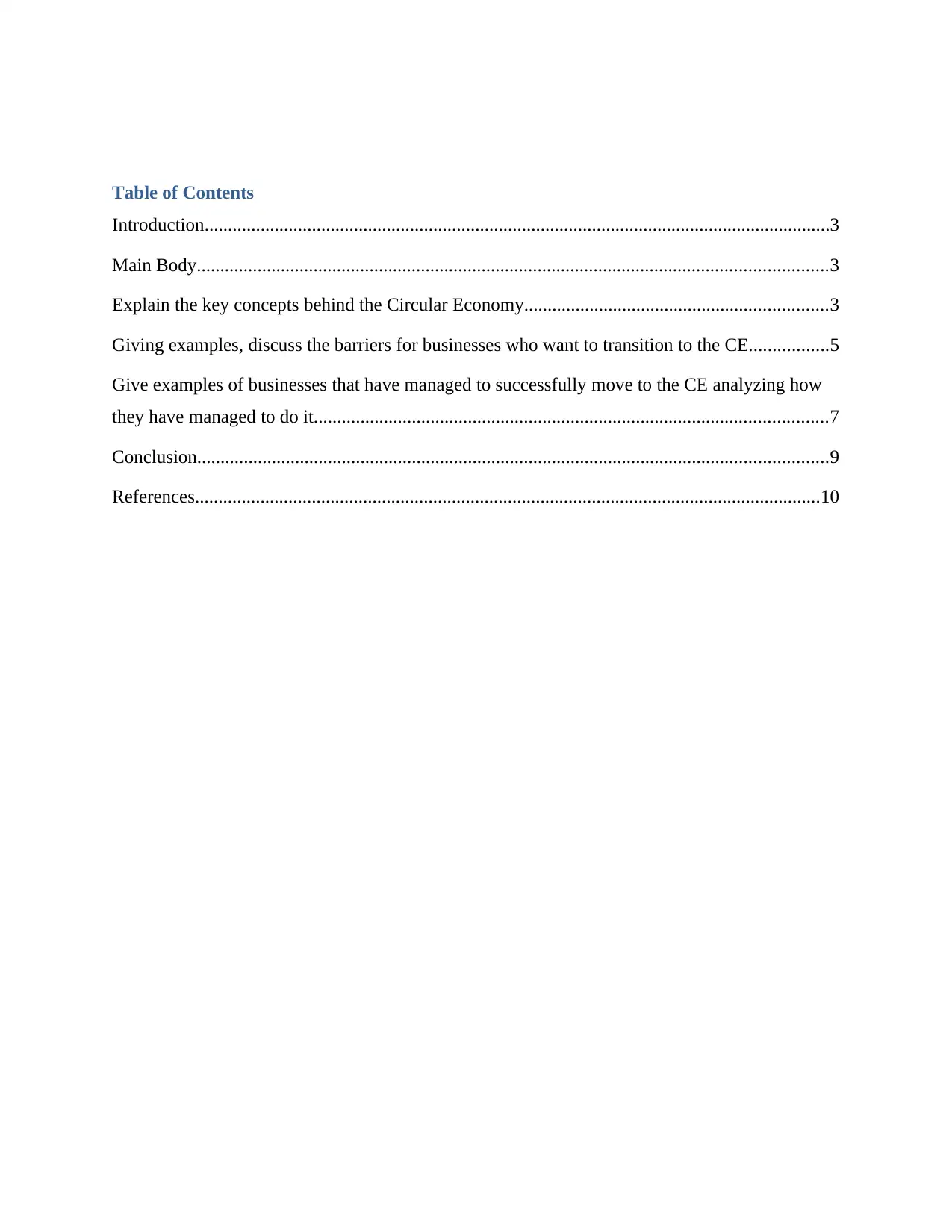
Table of Contents
Introduction......................................................................................................................................3
Main Body.......................................................................................................................................3
Explain the key concepts behind the Circular Economy.................................................................3
Giving examples, discuss the barriers for businesses who want to transition to the CE.................5
Give examples of businesses that have managed to successfully move to the CE analyzing how
they have managed to do it..............................................................................................................7
Conclusion.......................................................................................................................................9
References......................................................................................................................................10
Introduction......................................................................................................................................3
Main Body.......................................................................................................................................3
Explain the key concepts behind the Circular Economy.................................................................3
Giving examples, discuss the barriers for businesses who want to transition to the CE.................5
Give examples of businesses that have managed to successfully move to the CE analyzing how
they have managed to do it..............................................................................................................7
Conclusion.......................................................................................................................................9
References......................................................................................................................................10
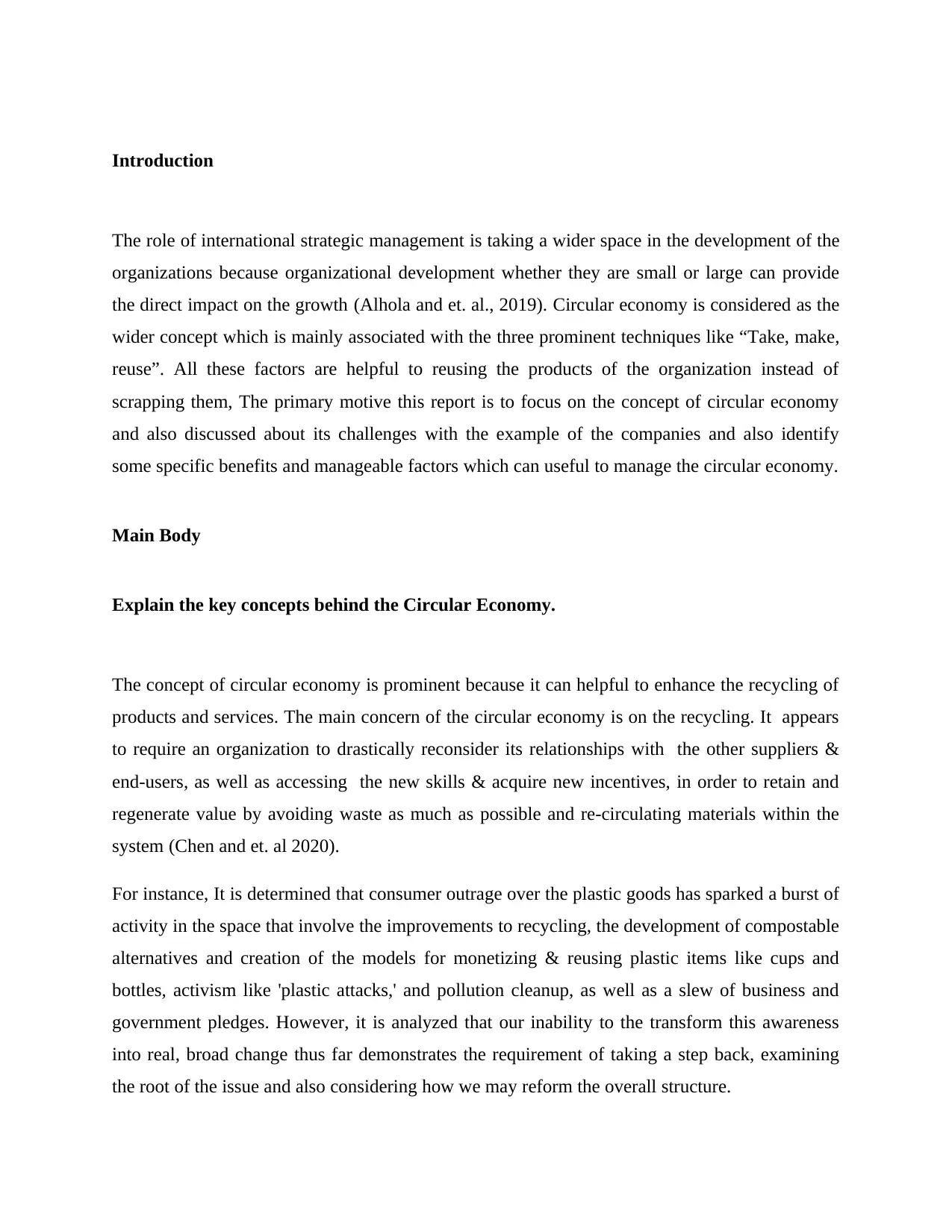
Introduction
The role of international strategic management is taking a wider space in the development of the
organizations because organizational development whether they are small or large can provide
the direct impact on the growth (Alhola and et. al., 2019). Circular economy is considered as the
wider concept which is mainly associated with the three prominent techniques like “Take, make,
reuse”. All these factors are helpful to reusing the products of the organization instead of
scrapping them, The primary motive this report is to focus on the concept of circular economy
and also discussed about its challenges with the example of the companies and also identify
some specific benefits and manageable factors which can useful to manage the circular economy.
Main Body
Explain the key concepts behind the Circular Economy.
The concept of circular economy is prominent because it can helpful to enhance the recycling of
products and services. The main concern of the circular economy is on the recycling. It appears
to require an organization to drastically reconsider its relationships with the other suppliers &
end-users, as well as accessing the new skills & acquire new incentives, in order to retain and
regenerate value by avoiding waste as much as possible and re-circulating materials within the
system (Chen and et. al 2020).
For instance, It is determined that consumer outrage over the plastic goods has sparked a burst of
activity in the space that involve the improvements to recycling, the development of compostable
alternatives and creation of the models for monetizing & reusing plastic items like cups and
bottles, activism like 'plastic attacks,' and pollution cleanup, as well as a slew of business and
government pledges. However, it is analyzed that our inability to the transform this awareness
into real, broad change thus far demonstrates the requirement of taking a step back, examining
the root of the issue and also considering how we may reform the overall structure.
The role of international strategic management is taking a wider space in the development of the
organizations because organizational development whether they are small or large can provide
the direct impact on the growth (Alhola and et. al., 2019). Circular economy is considered as the
wider concept which is mainly associated with the three prominent techniques like “Take, make,
reuse”. All these factors are helpful to reusing the products of the organization instead of
scrapping them, The primary motive this report is to focus on the concept of circular economy
and also discussed about its challenges with the example of the companies and also identify
some specific benefits and manageable factors which can useful to manage the circular economy.
Main Body
Explain the key concepts behind the Circular Economy.
The concept of circular economy is prominent because it can helpful to enhance the recycling of
products and services. The main concern of the circular economy is on the recycling. It appears
to require an organization to drastically reconsider its relationships with the other suppliers &
end-users, as well as accessing the new skills & acquire new incentives, in order to retain and
regenerate value by avoiding waste as much as possible and re-circulating materials within the
system (Chen and et. al 2020).
For instance, It is determined that consumer outrage over the plastic goods has sparked a burst of
activity in the space that involve the improvements to recycling, the development of compostable
alternatives and creation of the models for monetizing & reusing plastic items like cups and
bottles, activism like 'plastic attacks,' and pollution cleanup, as well as a slew of business and
government pledges. However, it is analyzed that our inability to the transform this awareness
into real, broad change thus far demonstrates the requirement of taking a step back, examining
the root of the issue and also considering how we may reform the overall structure.
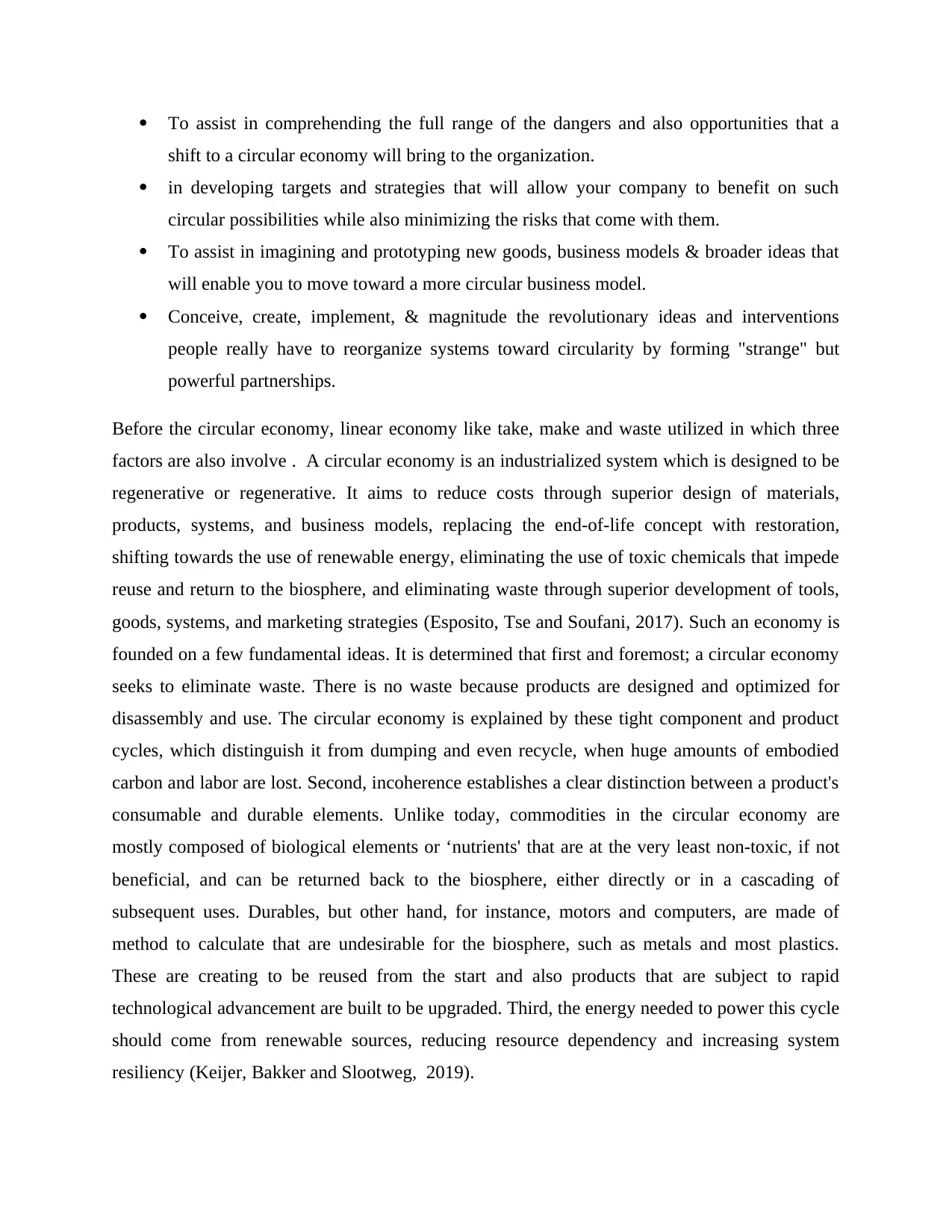
To assist in comprehending the full range of the dangers and also opportunities that a
shift to a circular economy will bring to the organization.
in developing targets and strategies that will allow your company to benefit on such
circular possibilities while also minimizing the risks that come with them.
To assist in imagining and prototyping new goods, business models & broader ideas that
will enable you to move toward a more circular business model.
Conceive, create, implement, & magnitude the revolutionary ideas and interventions
people really have to reorganize systems toward circularity by forming "strange" but
powerful partnerships.
Before the circular economy, linear economy like take, make and waste utilized in which three
factors are also involve . A circular economy is an industrialized system which is designed to be
regenerative or regenerative. It aims to reduce costs through superior design of materials,
products, systems, and business models, replacing the end-of-life concept with restoration,
shifting towards the use of renewable energy, eliminating the use of toxic chemicals that impede
reuse and return to the biosphere, and eliminating waste through superior development of tools,
goods, systems, and marketing strategies (Esposito, Tse and Soufani, 2017). Such an economy is
founded on a few fundamental ideas. It is determined that first and foremost; a circular economy
seeks to eliminate waste. There is no waste because products are designed and optimized for
disassembly and use. The circular economy is explained by these tight component and product
cycles, which distinguish it from dumping and even recycle, when huge amounts of embodied
carbon and labor are lost. Second, incoherence establishes a clear distinction between a product's
consumable and durable elements. Unlike today, commodities in the circular economy are
mostly composed of biological elements or ‘nutrients' that are at the very least non-toxic, if not
beneficial, and can be returned back to the biosphere, either directly or in a cascading of
subsequent uses. Durables, but other hand, for instance, motors and computers, are made of
method to calculate that are undesirable for the biosphere, such as metals and most plastics.
These are creating to be reused from the start and also products that are subject to rapid
technological advancement are built to be upgraded. Third, the energy needed to power this cycle
should come from renewable sources, reducing resource dependency and increasing system
resiliency (Keijer, Bakker and Slootweg, 2019).
shift to a circular economy will bring to the organization.
in developing targets and strategies that will allow your company to benefit on such
circular possibilities while also minimizing the risks that come with them.
To assist in imagining and prototyping new goods, business models & broader ideas that
will enable you to move toward a more circular business model.
Conceive, create, implement, & magnitude the revolutionary ideas and interventions
people really have to reorganize systems toward circularity by forming "strange" but
powerful partnerships.
Before the circular economy, linear economy like take, make and waste utilized in which three
factors are also involve . A circular economy is an industrialized system which is designed to be
regenerative or regenerative. It aims to reduce costs through superior design of materials,
products, systems, and business models, replacing the end-of-life concept with restoration,
shifting towards the use of renewable energy, eliminating the use of toxic chemicals that impede
reuse and return to the biosphere, and eliminating waste through superior development of tools,
goods, systems, and marketing strategies (Esposito, Tse and Soufani, 2017). Such an economy is
founded on a few fundamental ideas. It is determined that first and foremost; a circular economy
seeks to eliminate waste. There is no waste because products are designed and optimized for
disassembly and use. The circular economy is explained by these tight component and product
cycles, which distinguish it from dumping and even recycle, when huge amounts of embodied
carbon and labor are lost. Second, incoherence establishes a clear distinction between a product's
consumable and durable elements. Unlike today, commodities in the circular economy are
mostly composed of biological elements or ‘nutrients' that are at the very least non-toxic, if not
beneficial, and can be returned back to the biosphere, either directly or in a cascading of
subsequent uses. Durables, but other hand, for instance, motors and computers, are made of
method to calculate that are undesirable for the biosphere, such as metals and most plastics.
These are creating to be reused from the start and also products that are subject to rapid
technological advancement are built to be upgraded. Third, the energy needed to power this cycle
should come from renewable sources, reducing resource dependency and increasing system
resiliency (Keijer, Bakker and Slootweg, 2019).
Secure Best Marks with AI Grader
Need help grading? Try our AI Grader for instant feedback on your assignments.
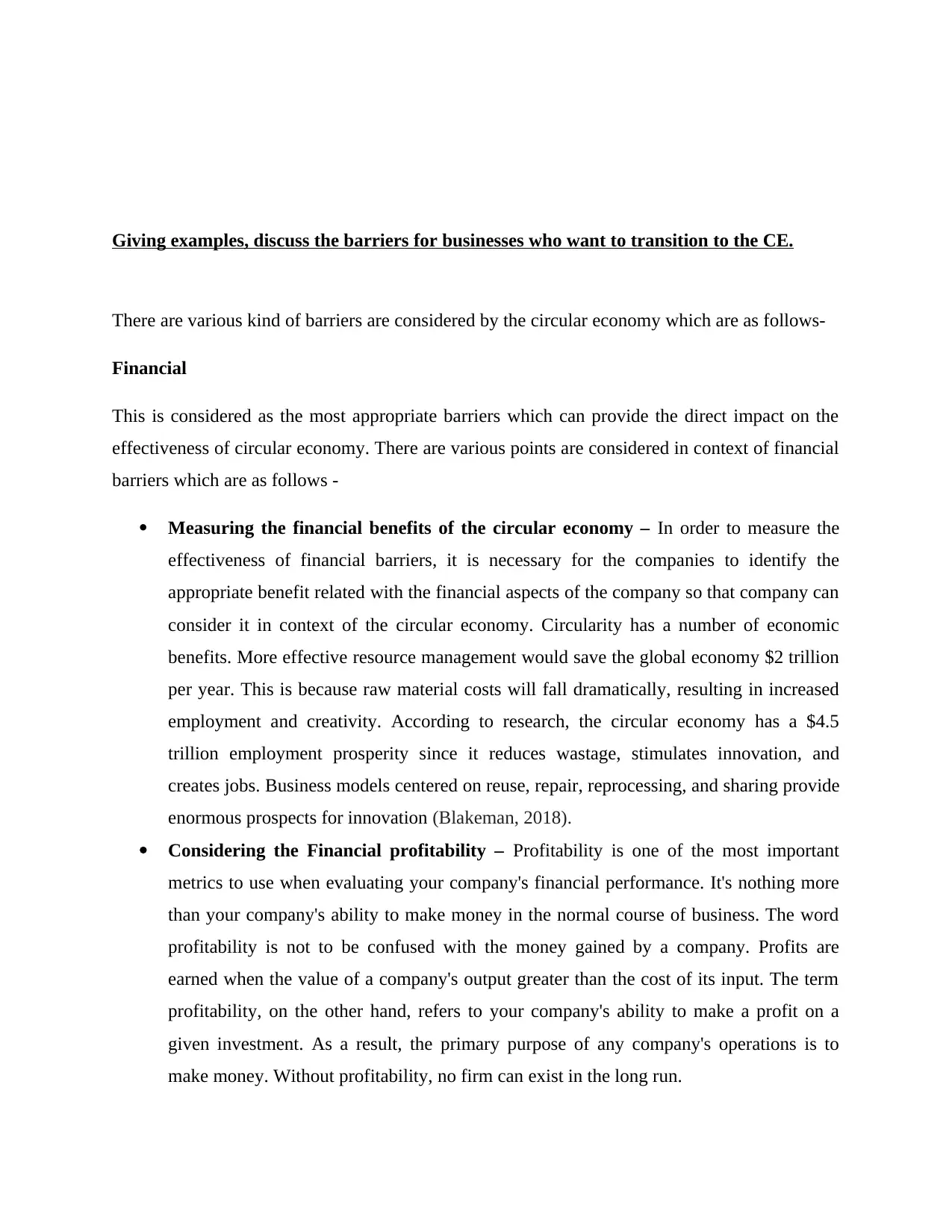
Giving examples, discuss the barriers for businesses who want to transition to the CE.
There are various kind of barriers are considered by the circular economy which are as follows-
Financial
This is considered as the most appropriate barriers which can provide the direct impact on the
effectiveness of circular economy. There are various points are considered in context of financial
barriers which are as follows -
Measuring the financial benefits of the circular economy – In order to measure the
effectiveness of financial barriers, it is necessary for the companies to identify the
appropriate benefit related with the financial aspects of the company so that company can
consider it in context of the circular economy. Circularity has a number of economic
benefits. More effective resource management would save the global economy $2 trillion
per year. This is because raw material costs will fall dramatically, resulting in increased
employment and creativity. According to research, the circular economy has a $4.5
trillion employment prosperity since it reduces wastage, stimulates innovation, and
creates jobs. Business models centered on reuse, repair, reprocessing, and sharing provide
enormous prospects for innovation (Blakeman, 2018).
Considering the Financial profitability – Profitability is one of the most important
metrics to use when evaluating your company's financial performance. It's nothing more
than your company's ability to make money in the normal course of business. The word
profitability is not to be confused with the money gained by a company. Profits are
earned when the value of a company's output greater than the cost of its input. The term
profitability, on the other hand, refers to your company's ability to make a profit on a
given investment. As a result, the primary purpose of any company's operations is to
make money. Without profitability, no firm can exist in the long run.
There are various kind of barriers are considered by the circular economy which are as follows-
Financial
This is considered as the most appropriate barriers which can provide the direct impact on the
effectiveness of circular economy. There are various points are considered in context of financial
barriers which are as follows -
Measuring the financial benefits of the circular economy – In order to measure the
effectiveness of financial barriers, it is necessary for the companies to identify the
appropriate benefit related with the financial aspects of the company so that company can
consider it in context of the circular economy. Circularity has a number of economic
benefits. More effective resource management would save the global economy $2 trillion
per year. This is because raw material costs will fall dramatically, resulting in increased
employment and creativity. According to research, the circular economy has a $4.5
trillion employment prosperity since it reduces wastage, stimulates innovation, and
creates jobs. Business models centered on reuse, repair, reprocessing, and sharing provide
enormous prospects for innovation (Blakeman, 2018).
Considering the Financial profitability – Profitability is one of the most important
metrics to use when evaluating your company's financial performance. It's nothing more
than your company's ability to make money in the normal course of business. The word
profitability is not to be confused with the money gained by a company. Profits are
earned when the value of a company's output greater than the cost of its input. The term
profitability, on the other hand, refers to your company's ability to make a profit on a
given investment. As a result, the primary purpose of any company's operations is to
make money. Without profitability, no firm can exist in the long run.
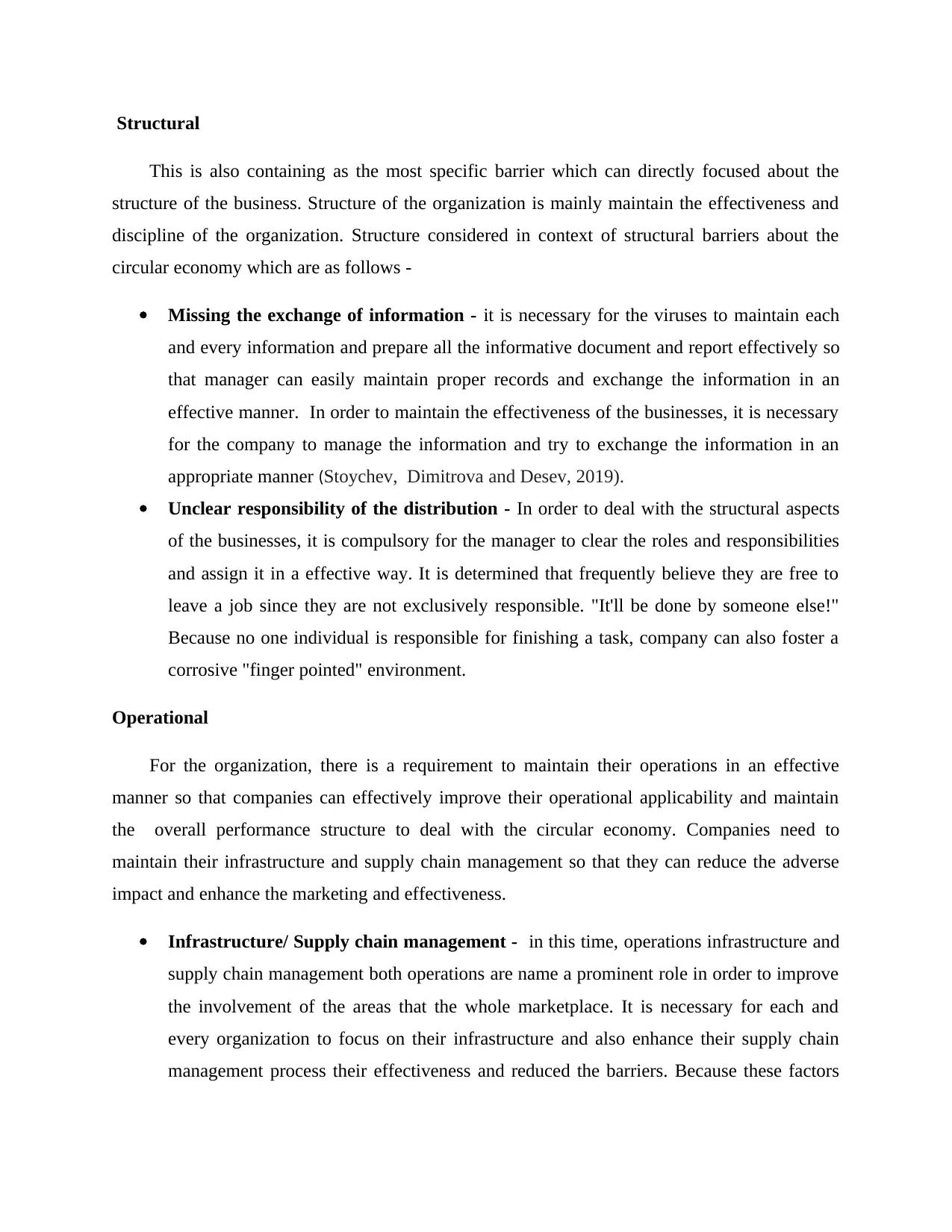
Structural
This is also containing as the most specific barrier which can directly focused about the
structure of the business. Structure of the organization is mainly maintain the effectiveness and
discipline of the organization. Structure considered in context of structural barriers about the
circular economy which are as follows -
Missing the exchange of information - it is necessary for the viruses to maintain each
and every information and prepare all the informative document and report effectively so
that manager can easily maintain proper records and exchange the information in an
effective manner. In order to maintain the effectiveness of the businesses, it is necessary
for the company to manage the information and try to exchange the information in an
appropriate manner (Stoychev, Dimitrova and Desev, 2019).
Unclear responsibility of the distribution - In order to deal with the structural aspects
of the businesses, it is compulsory for the manager to clear the roles and responsibilities
and assign it in a effective way. It is determined that frequently believe they are free to
leave a job since they are not exclusively responsible. "It'll be done by someone else!"
Because no one individual is responsible for finishing a task, company can also foster a
corrosive "finger pointed" environment.
Operational
For the organization, there is a requirement to maintain their operations in an effective
manner so that companies can effectively improve their operational applicability and maintain
the overall performance structure to deal with the circular economy. Companies need to
maintain their infrastructure and supply chain management so that they can reduce the adverse
impact and enhance the marketing and effectiveness.
Infrastructure/ Supply chain management - in this time, operations infrastructure and
supply chain management both operations are name a prominent role in order to improve
the involvement of the areas that the whole marketplace. It is necessary for each and
every organization to focus on their infrastructure and also enhance their supply chain
management process their effectiveness and reduced the barriers. Because these factors
This is also containing as the most specific barrier which can directly focused about the
structure of the business. Structure of the organization is mainly maintain the effectiveness and
discipline of the organization. Structure considered in context of structural barriers about the
circular economy which are as follows -
Missing the exchange of information - it is necessary for the viruses to maintain each
and every information and prepare all the informative document and report effectively so
that manager can easily maintain proper records and exchange the information in an
effective manner. In order to maintain the effectiveness of the businesses, it is necessary
for the company to manage the information and try to exchange the information in an
appropriate manner (Stoychev, Dimitrova and Desev, 2019).
Unclear responsibility of the distribution - In order to deal with the structural aspects
of the businesses, it is compulsory for the manager to clear the roles and responsibilities
and assign it in a effective way. It is determined that frequently believe they are free to
leave a job since they are not exclusively responsible. "It'll be done by someone else!"
Because no one individual is responsible for finishing a task, company can also foster a
corrosive "finger pointed" environment.
Operational
For the organization, there is a requirement to maintain their operations in an effective
manner so that companies can effectively improve their operational applicability and maintain
the overall performance structure to deal with the circular economy. Companies need to
maintain their infrastructure and supply chain management so that they can reduce the adverse
impact and enhance the marketing and effectiveness.
Infrastructure/ Supply chain management - in this time, operations infrastructure and
supply chain management both operations are name a prominent role in order to improve
the involvement of the areas that the whole marketplace. It is necessary for each and
every organization to focus on their infrastructure and also enhance their supply chain
management process their effectiveness and reduced the barriers. Because these factors
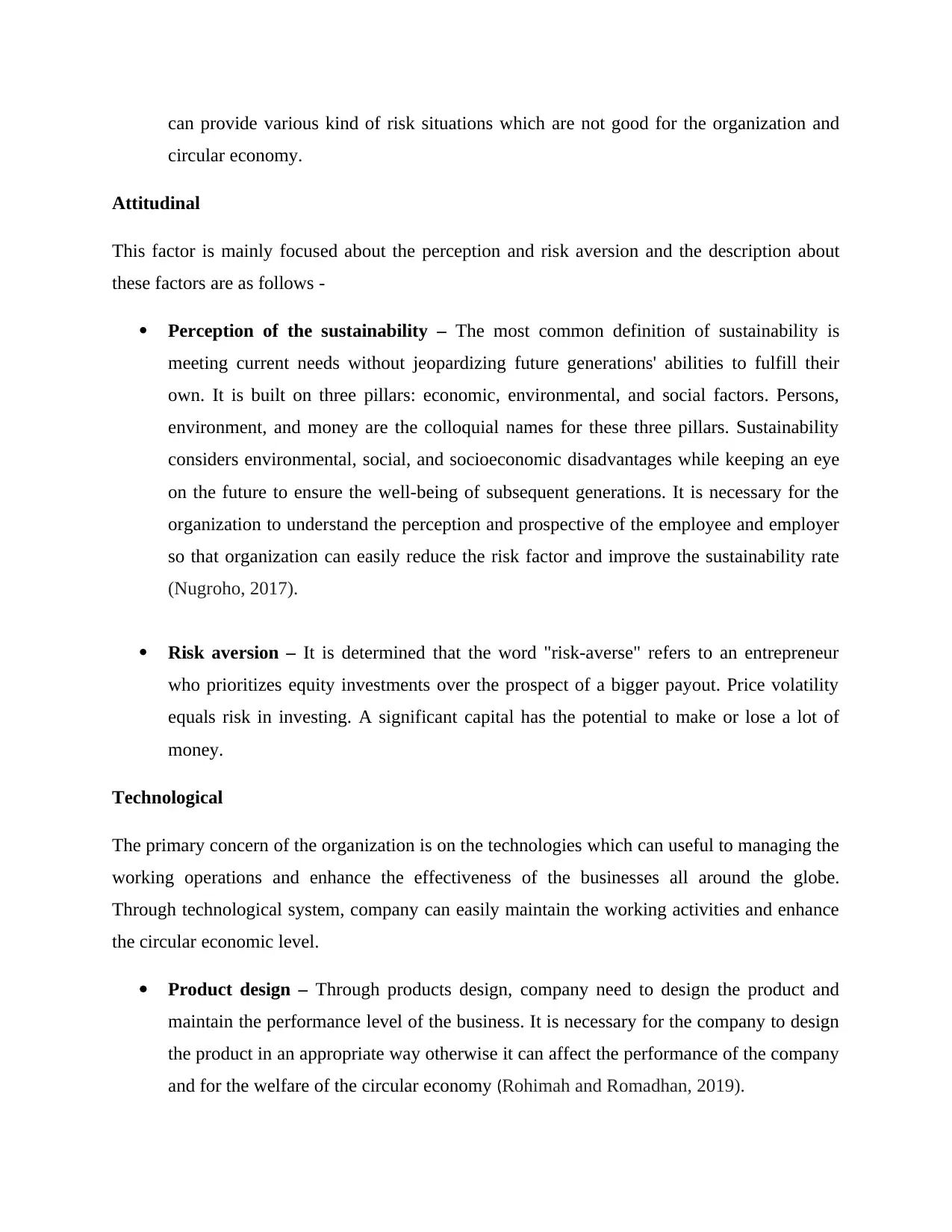
can provide various kind of risk situations which are not good for the organization and
circular economy.
Attitudinal
This factor is mainly focused about the perception and risk aversion and the description about
these factors are as follows -
Perception of the sustainability – The most common definition of sustainability is
meeting current needs without jeopardizing future generations' abilities to fulfill their
own. It is built on three pillars: economic, environmental, and social factors. Persons,
environment, and money are the colloquial names for these three pillars. Sustainability
considers environmental, social, and socioeconomic disadvantages while keeping an eye
on the future to ensure the well-being of subsequent generations. It is necessary for the
organization to understand the perception and prospective of the employee and employer
so that organization can easily reduce the risk factor and improve the sustainability rate
(Nugroho, 2017).
Risk aversion – It is determined that the word "risk-averse" refers to an entrepreneur
who prioritizes equity investments over the prospect of a bigger payout. Price volatility
equals risk in investing. A significant capital has the potential to make or lose a lot of
money.
Technological
The primary concern of the organization is on the technologies which can useful to managing the
working operations and enhance the effectiveness of the businesses all around the globe.
Through technological system, company can easily maintain the working activities and enhance
the circular economic level.
Product design – Through products design, company need to design the product and
maintain the performance level of the business. It is necessary for the company to design
the product in an appropriate way otherwise it can affect the performance of the company
and for the welfare of the circular economy (Rohimah and Romadhan, 2019).
circular economy.
Attitudinal
This factor is mainly focused about the perception and risk aversion and the description about
these factors are as follows -
Perception of the sustainability – The most common definition of sustainability is
meeting current needs without jeopardizing future generations' abilities to fulfill their
own. It is built on three pillars: economic, environmental, and social factors. Persons,
environment, and money are the colloquial names for these three pillars. Sustainability
considers environmental, social, and socioeconomic disadvantages while keeping an eye
on the future to ensure the well-being of subsequent generations. It is necessary for the
organization to understand the perception and prospective of the employee and employer
so that organization can easily reduce the risk factor and improve the sustainability rate
(Nugroho, 2017).
Risk aversion – It is determined that the word "risk-averse" refers to an entrepreneur
who prioritizes equity investments over the prospect of a bigger payout. Price volatility
equals risk in investing. A significant capital has the potential to make or lose a lot of
money.
Technological
The primary concern of the organization is on the technologies which can useful to managing the
working operations and enhance the effectiveness of the businesses all around the globe.
Through technological system, company can easily maintain the working activities and enhance
the circular economic level.
Product design – Through products design, company need to design the product and
maintain the performance level of the business. It is necessary for the company to design
the product in an appropriate way otherwise it can affect the performance of the company
and for the welfare of the circular economy (Rohimah and Romadhan, 2019).
Paraphrase This Document
Need a fresh take? Get an instant paraphrase of this document with our AI Paraphraser
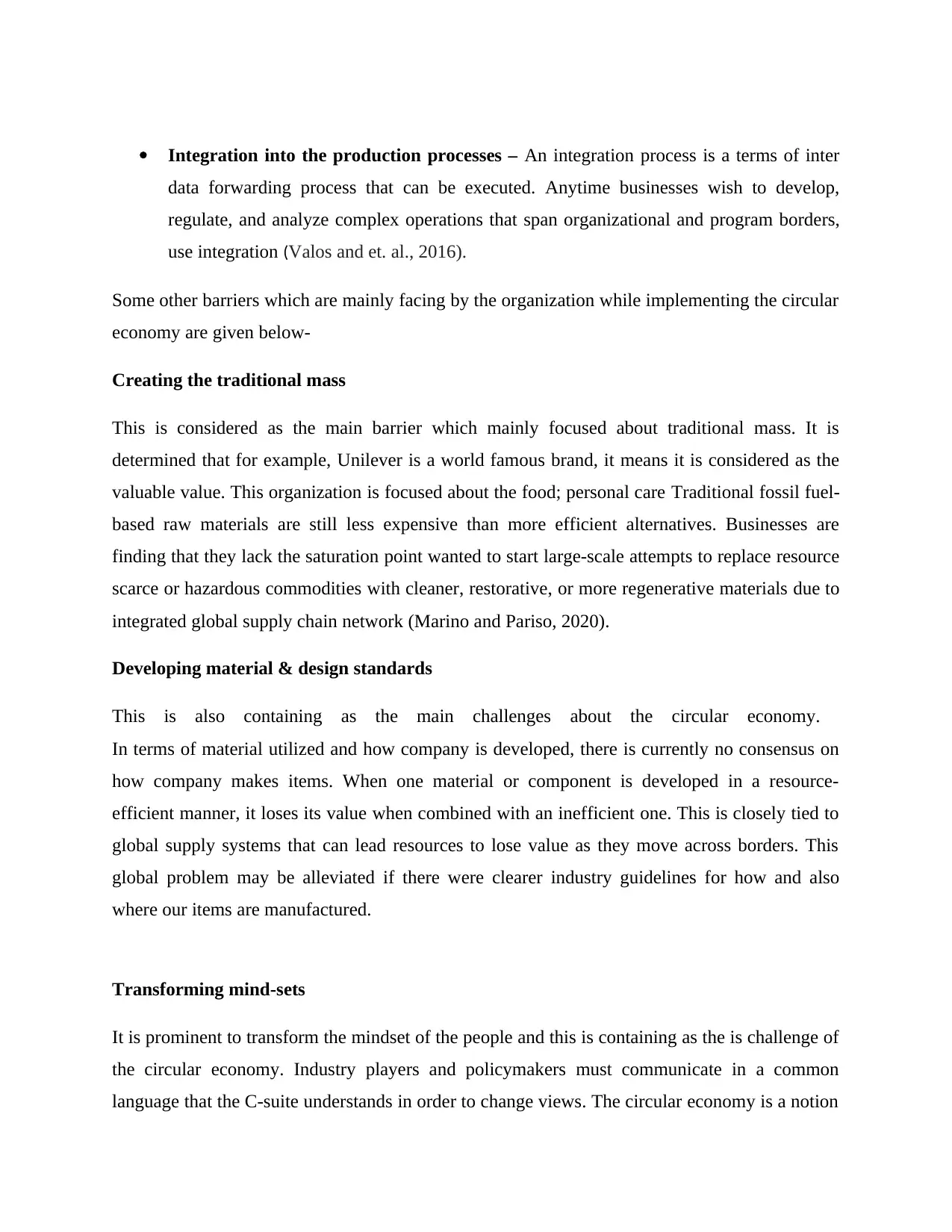
Integration into the production processes – An integration process is a terms of inter
data forwarding process that can be executed. Anytime businesses wish to develop,
regulate, and analyze complex operations that span organizational and program borders,
use integration (Valos and et. al., 2016).
Some other barriers which are mainly facing by the organization while implementing the circular
economy are given below-
Creating the traditional mass
This is considered as the main barrier which mainly focused about traditional mass. It is
determined that for example, Unilever is a world famous brand, it means it is considered as the
valuable value. This organization is focused about the food; personal care Traditional fossil fuel-
based raw materials are still less expensive than more efficient alternatives. Businesses are
finding that they lack the saturation point wanted to start large-scale attempts to replace resource
scarce or hazardous commodities with cleaner, restorative, or more regenerative materials due to
integrated global supply chain network (Marino and Pariso, 2020).
Developing material & design standards
This is also containing as the main challenges about the circular economy.
In terms of material utilized and how company is developed, there is currently no consensus on
how company makes items. When one material or component is developed in a resource-
efficient manner, it loses its value when combined with an inefficient one. This is closely tied to
global supply systems that can lead resources to lose value as they move across borders. This
global problem may be alleviated if there were clearer industry guidelines for how and also
where our items are manufactured.
Transforming mind-sets
It is prominent to transform the mindset of the people and this is containing as the is challenge of
the circular economy. Industry players and policymakers must communicate in a common
language that the C-suite understands in order to change views. The circular economy is a notion
data forwarding process that can be executed. Anytime businesses wish to develop,
regulate, and analyze complex operations that span organizational and program borders,
use integration (Valos and et. al., 2016).
Some other barriers which are mainly facing by the organization while implementing the circular
economy are given below-
Creating the traditional mass
This is considered as the main barrier which mainly focused about traditional mass. It is
determined that for example, Unilever is a world famous brand, it means it is considered as the
valuable value. This organization is focused about the food; personal care Traditional fossil fuel-
based raw materials are still less expensive than more efficient alternatives. Businesses are
finding that they lack the saturation point wanted to start large-scale attempts to replace resource
scarce or hazardous commodities with cleaner, restorative, or more regenerative materials due to
integrated global supply chain network (Marino and Pariso, 2020).
Developing material & design standards
This is also containing as the main challenges about the circular economy.
In terms of material utilized and how company is developed, there is currently no consensus on
how company makes items. When one material or component is developed in a resource-
efficient manner, it loses its value when combined with an inefficient one. This is closely tied to
global supply systems that can lead resources to lose value as they move across borders. This
global problem may be alleviated if there were clearer industry guidelines for how and also
where our items are manufactured.
Transforming mind-sets
It is prominent to transform the mindset of the people and this is containing as the is challenge of
the circular economy. Industry players and policymakers must communicate in a common
language that the C-suite understands in order to change views. The circular economy is a notion
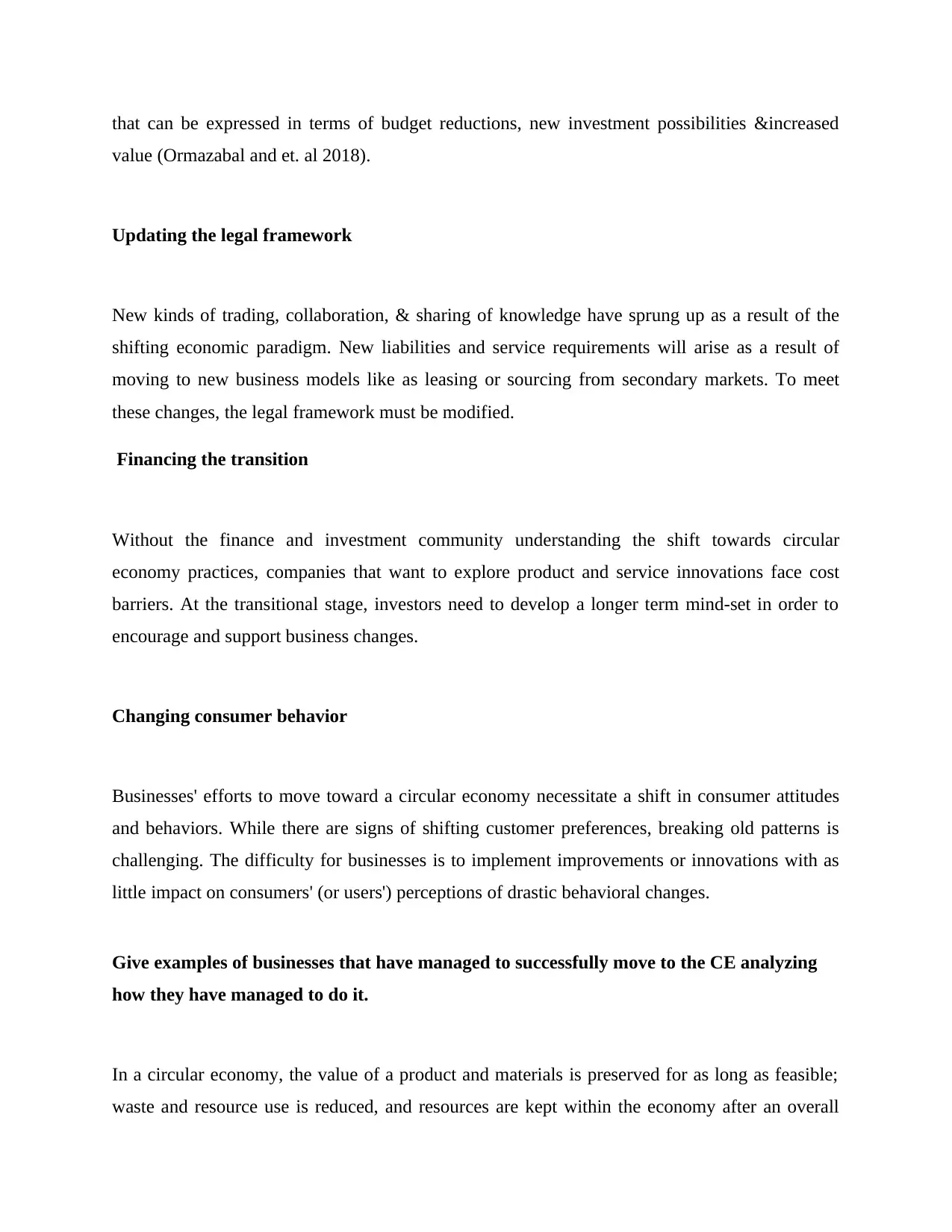
that can be expressed in terms of budget reductions, new investment possibilities &increased
value (Ormazabal and et. al 2018).
Updating the legal framework
New kinds of trading, collaboration, & sharing of knowledge have sprung up as a result of the
shifting economic paradigm. New liabilities and service requirements will arise as a result of
moving to new business models like as leasing or sourcing from secondary markets. To meet
these changes, the legal framework must be modified.
Financing the transition
Without the finance and investment community understanding the shift towards circular
economy practices, companies that want to explore product and service innovations face cost
barriers. At the transitional stage, investors need to develop a longer term mind-set in order to
encourage and support business changes.
Changing consumer behavior
Businesses' efforts to move toward a circular economy necessitate a shift in consumer attitudes
and behaviors. While there are signs of shifting customer preferences, breaking old patterns is
challenging. The difficulty for businesses is to implement improvements or innovations with as
little impact on consumers' (or users') perceptions of drastic behavioral changes.
Give examples of businesses that have managed to successfully move to the CE analyzing
how they have managed to do it.
In a circular economy, the value of a product and materials is preserved for as long as feasible;
waste and resource use is reduced, and resources are kept within the economy after an overall
value (Ormazabal and et. al 2018).
Updating the legal framework
New kinds of trading, collaboration, & sharing of knowledge have sprung up as a result of the
shifting economic paradigm. New liabilities and service requirements will arise as a result of
moving to new business models like as leasing or sourcing from secondary markets. To meet
these changes, the legal framework must be modified.
Financing the transition
Without the finance and investment community understanding the shift towards circular
economy practices, companies that want to explore product and service innovations face cost
barriers. At the transitional stage, investors need to develop a longer term mind-set in order to
encourage and support business changes.
Changing consumer behavior
Businesses' efforts to move toward a circular economy necessitate a shift in consumer attitudes
and behaviors. While there are signs of shifting customer preferences, breaking old patterns is
challenging. The difficulty for businesses is to implement improvements or innovations with as
little impact on consumers' (or users') perceptions of drastic behavioral changes.
Give examples of businesses that have managed to successfully move to the CE analyzing
how they have managed to do it.
In a circular economy, the value of a product and materials is preserved for as long as feasible;
waste and resource use is reduced, and resources are kept within the economy after an overall
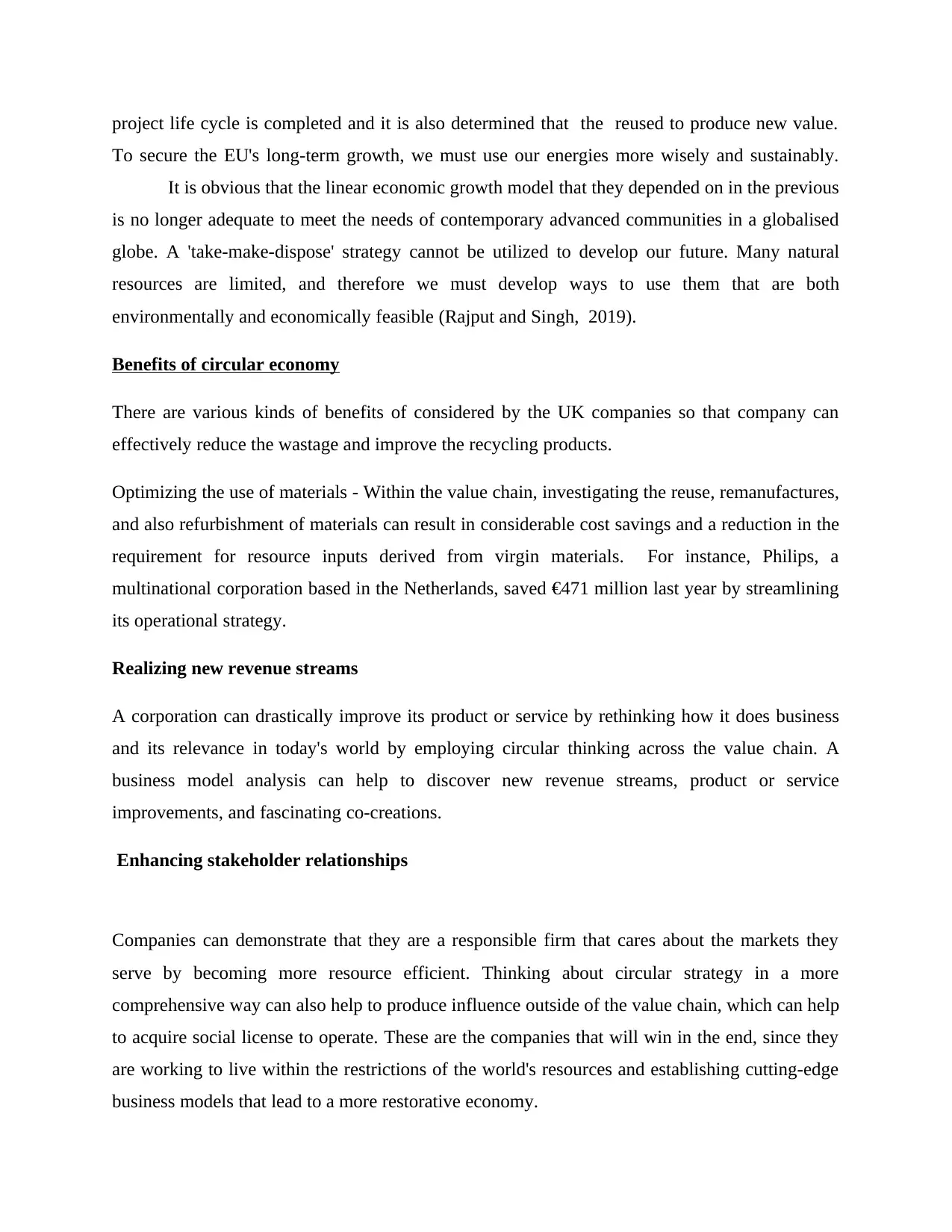
project life cycle is completed and it is also determined that the reused to produce new value.
To secure the EU's long-term growth, we must use our energies more wisely and sustainably.
It is obvious that the linear economic growth model that they depended on in the previous
is no longer adequate to meet the needs of contemporary advanced communities in a globalised
globe. A 'take-make-dispose' strategy cannot be utilized to develop our future. Many natural
resources are limited, and therefore we must develop ways to use them that are both
environmentally and economically feasible (Rajput and Singh, 2019).
Benefits of circular economy
There are various kinds of benefits of considered by the UK companies so that company can
effectively reduce the wastage and improve the recycling products.
Optimizing the use of materials - Within the value chain, investigating the reuse, remanufactures,
and also refurbishment of materials can result in considerable cost savings and a reduction in the
requirement for resource inputs derived from virgin materials. For instance, Philips, a
multinational corporation based in the Netherlands, saved €471 million last year by streamlining
its operational strategy.
Realizing new revenue streams
A corporation can drastically improve its product or service by rethinking how it does business
and its relevance in today's world by employing circular thinking across the value chain. A
business model analysis can help to discover new revenue streams, product or service
improvements, and fascinating co-creations.
Enhancing stakeholder relationships
Companies can demonstrate that they are a responsible firm that cares about the markets they
serve by becoming more resource efficient. Thinking about circular strategy in a more
comprehensive way can also help to produce influence outside of the value chain, which can help
to acquire social license to operate. These are the companies that will win in the end, since they
are working to live within the restrictions of the world's resources and establishing cutting-edge
business models that lead to a more restorative economy.
To secure the EU's long-term growth, we must use our energies more wisely and sustainably.
It is obvious that the linear economic growth model that they depended on in the previous
is no longer adequate to meet the needs of contemporary advanced communities in a globalised
globe. A 'take-make-dispose' strategy cannot be utilized to develop our future. Many natural
resources are limited, and therefore we must develop ways to use them that are both
environmentally and economically feasible (Rajput and Singh, 2019).
Benefits of circular economy
There are various kinds of benefits of considered by the UK companies so that company can
effectively reduce the wastage and improve the recycling products.
Optimizing the use of materials - Within the value chain, investigating the reuse, remanufactures,
and also refurbishment of materials can result in considerable cost savings and a reduction in the
requirement for resource inputs derived from virgin materials. For instance, Philips, a
multinational corporation based in the Netherlands, saved €471 million last year by streamlining
its operational strategy.
Realizing new revenue streams
A corporation can drastically improve its product or service by rethinking how it does business
and its relevance in today's world by employing circular thinking across the value chain. A
business model analysis can help to discover new revenue streams, product or service
improvements, and fascinating co-creations.
Enhancing stakeholder relationships
Companies can demonstrate that they are a responsible firm that cares about the markets they
serve by becoming more resource efficient. Thinking about circular strategy in a more
comprehensive way can also help to produce influence outside of the value chain, which can help
to acquire social license to operate. These are the companies that will win in the end, since they
are working to live within the restrictions of the world's resources and establishing cutting-edge
business models that lead to a more restorative economy.
Secure Best Marks with AI Grader
Need help grading? Try our AI Grader for instant feedback on your assignments.
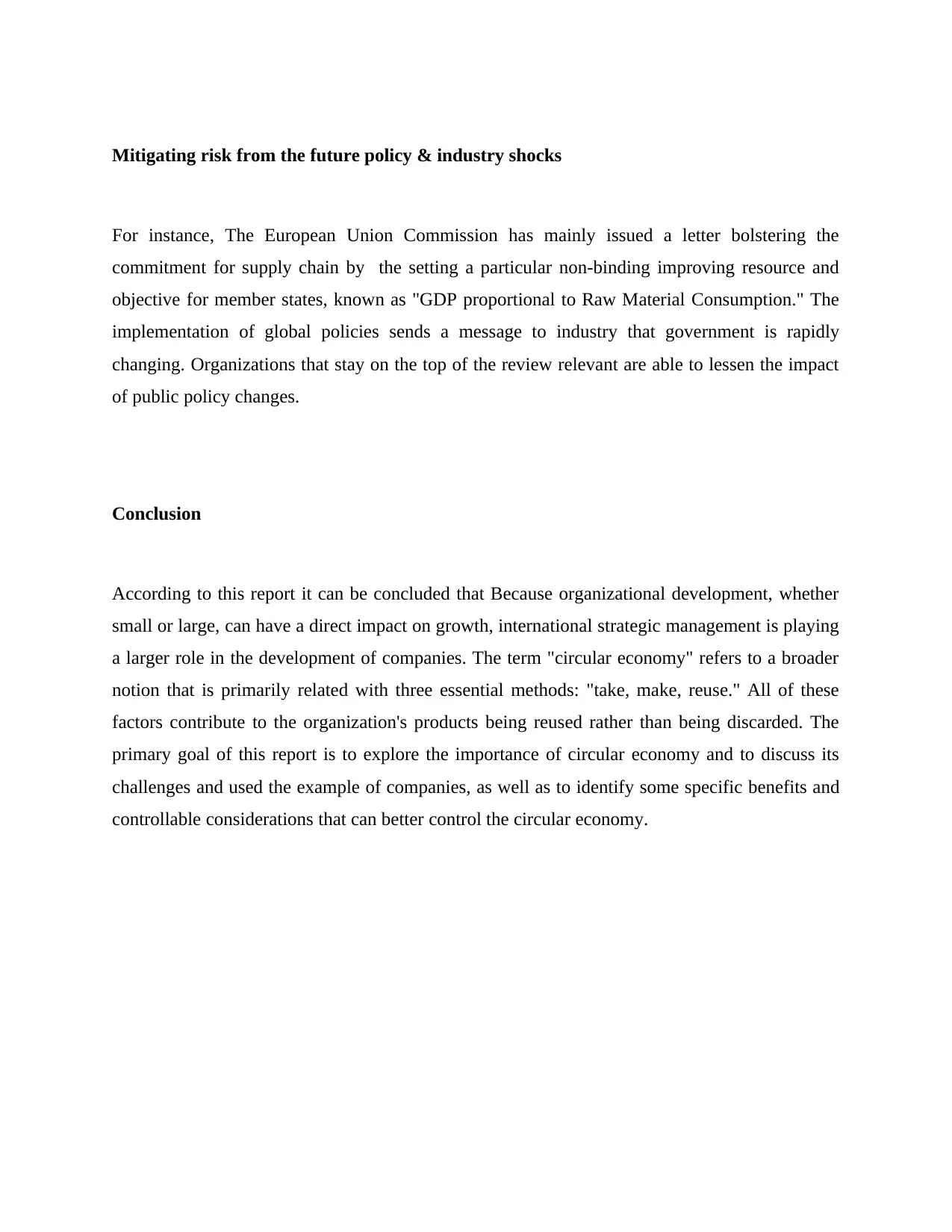
Mitigating risk from the future policy & industry shocks
For instance, The European Union Commission has mainly issued a letter bolstering the
commitment for supply chain by the setting a particular non-binding improving resource and
objective for member states, known as "GDP proportional to Raw Material Consumption." The
implementation of global policies sends a message to industry that government is rapidly
changing. Organizations that stay on the top of the review relevant are able to lessen the impact
of public policy changes.
Conclusion
According to this report it can be concluded that Because organizational development, whether
small or large, can have a direct impact on growth, international strategic management is playing
a larger role in the development of companies. The term "circular economy" refers to a broader
notion that is primarily related with three essential methods: "take, make, reuse." All of these
factors contribute to the organization's products being reused rather than being discarded. The
primary goal of this report is to explore the importance of circular economy and to discuss its
challenges and used the example of companies, as well as to identify some specific benefits and
controllable considerations that can better control the circular economy.
For instance, The European Union Commission has mainly issued a letter bolstering the
commitment for supply chain by the setting a particular non-binding improving resource and
objective for member states, known as "GDP proportional to Raw Material Consumption." The
implementation of global policies sends a message to industry that government is rapidly
changing. Organizations that stay on the top of the review relevant are able to lessen the impact
of public policy changes.
Conclusion
According to this report it can be concluded that Because organizational development, whether
small or large, can have a direct impact on growth, international strategic management is playing
a larger role in the development of companies. The term "circular economy" refers to a broader
notion that is primarily related with three essential methods: "take, make, reuse." All of these
factors contribute to the organization's products being reused rather than being discarded. The
primary goal of this report is to explore the importance of circular economy and to discuss its
challenges and used the example of companies, as well as to identify some specific benefits and
controllable considerations that can better control the circular economy.
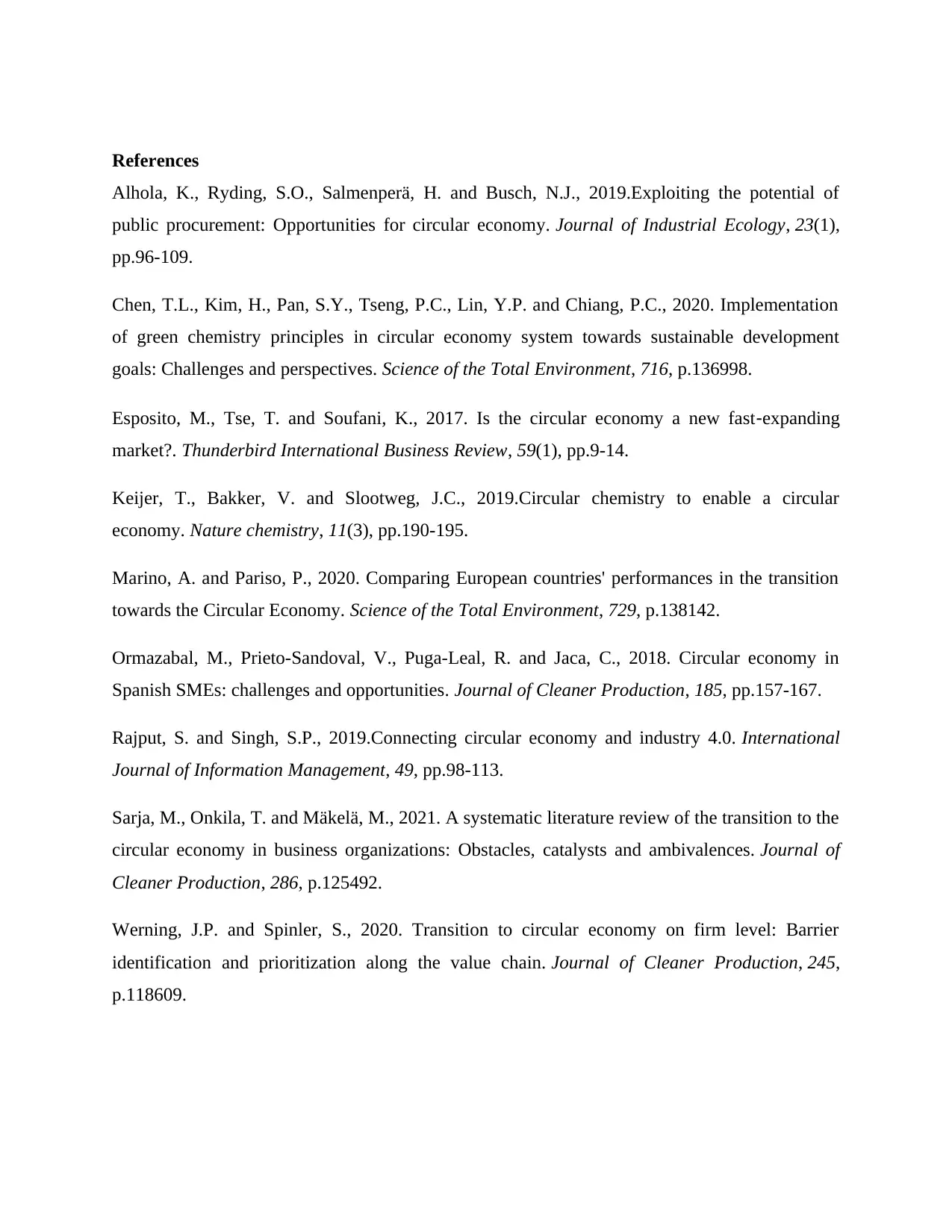
References
Alhola, K., Ryding, S.O., Salmenperä, H. and Busch, N.J., 2019.Exploiting the potential of
public procurement: Opportunities for circular economy. Journal of Industrial Ecology, 23(1),
pp.96-109.
Chen, T.L., Kim, H., Pan, S.Y., Tseng, P.C., Lin, Y.P. and Chiang, P.C., 2020. Implementation
of green chemistry principles in circular economy system towards sustainable development
goals: Challenges and perspectives. Science of the Total Environment, 716, p.136998.
Esposito, M., Tse, T. and Soufani, K., 2017. Is the circular economy a new fast‐expanding
market?. Thunderbird International Business Review, 59(1), pp.9-14.
Keijer, T., Bakker, V. and Slootweg, J.C., 2019.Circular chemistry to enable a circular
economy. Nature chemistry, 11(3), pp.190-195.
Marino, A. and Pariso, P., 2020. Comparing European countries' performances in the transition
towards the Circular Economy. Science of the Total Environment, 729, p.138142.
Ormazabal, M., Prieto-Sandoval, V., Puga-Leal, R. and Jaca, C., 2018. Circular economy in
Spanish SMEs: challenges and opportunities. Journal of Cleaner Production, 185, pp.157-167.
Rajput, S. and Singh, S.P., 2019.Connecting circular economy and industry 4.0. International
Journal of Information Management, 49, pp.98-113.
Sarja, M., Onkila, T. and Mäkelä, M., 2021. A systematic literature review of the transition to the
circular economy in business organizations: Obstacles, catalysts and ambivalences. Journal of
Cleaner Production, 286, p.125492.
Werning, J.P. and Spinler, S., 2020. Transition to circular economy on firm level: Barrier
identification and prioritization along the value chain. Journal of Cleaner Production, 245,
p.118609.
Alhola, K., Ryding, S.O., Salmenperä, H. and Busch, N.J., 2019.Exploiting the potential of
public procurement: Opportunities for circular economy. Journal of Industrial Ecology, 23(1),
pp.96-109.
Chen, T.L., Kim, H., Pan, S.Y., Tseng, P.C., Lin, Y.P. and Chiang, P.C., 2020. Implementation
of green chemistry principles in circular economy system towards sustainable development
goals: Challenges and perspectives. Science of the Total Environment, 716, p.136998.
Esposito, M., Tse, T. and Soufani, K., 2017. Is the circular economy a new fast‐expanding
market?. Thunderbird International Business Review, 59(1), pp.9-14.
Keijer, T., Bakker, V. and Slootweg, J.C., 2019.Circular chemistry to enable a circular
economy. Nature chemistry, 11(3), pp.190-195.
Marino, A. and Pariso, P., 2020. Comparing European countries' performances in the transition
towards the Circular Economy. Science of the Total Environment, 729, p.138142.
Ormazabal, M., Prieto-Sandoval, V., Puga-Leal, R. and Jaca, C., 2018. Circular economy in
Spanish SMEs: challenges and opportunities. Journal of Cleaner Production, 185, pp.157-167.
Rajput, S. and Singh, S.P., 2019.Connecting circular economy and industry 4.0. International
Journal of Information Management, 49, pp.98-113.
Sarja, M., Onkila, T. and Mäkelä, M., 2021. A systematic literature review of the transition to the
circular economy in business organizations: Obstacles, catalysts and ambivalences. Journal of
Cleaner Production, 286, p.125492.
Werning, J.P. and Spinler, S., 2020. Transition to circular economy on firm level: Barrier
identification and prioritization along the value chain. Journal of Cleaner Production, 245,
p.118609.
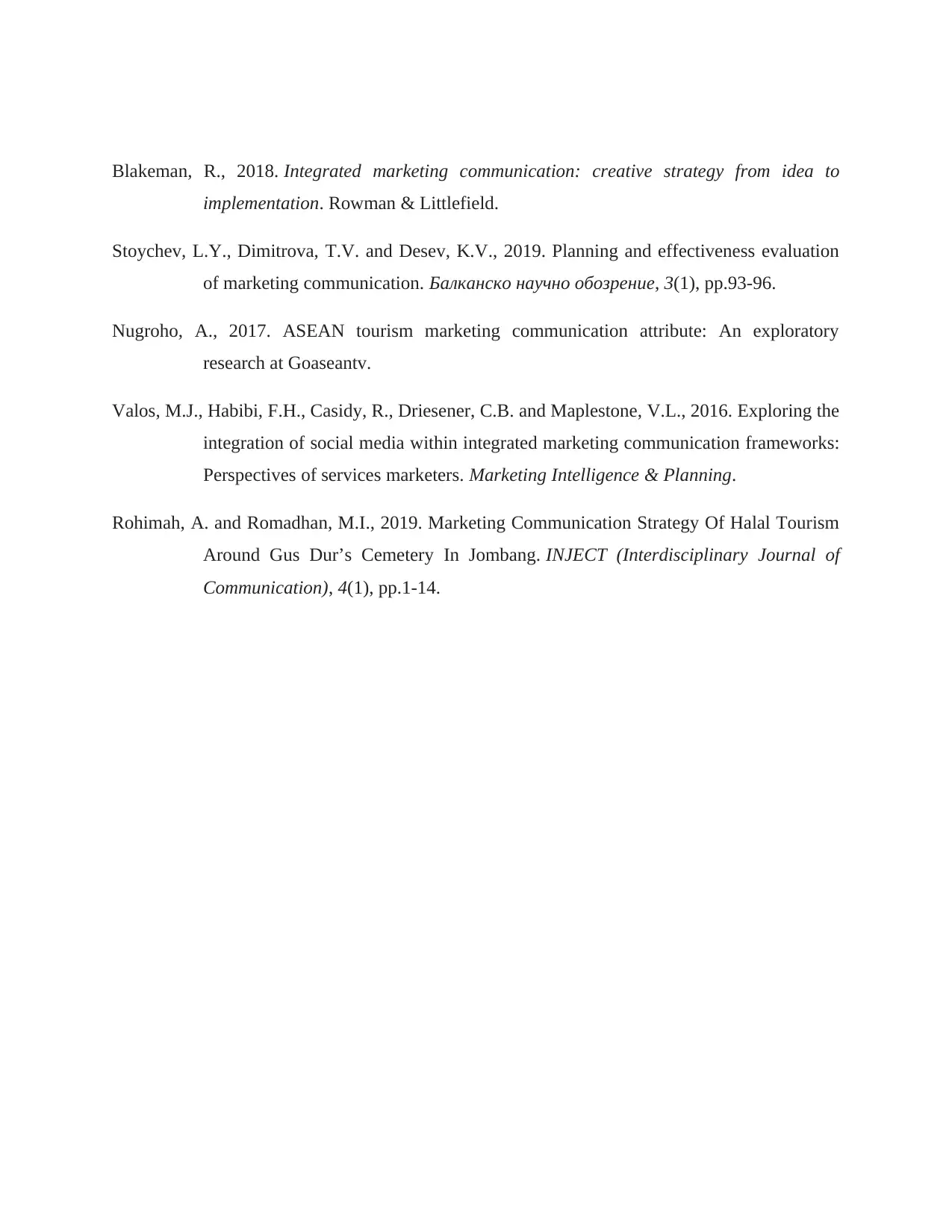
Blakeman, R., 2018. Integrated marketing communication: creative strategy from idea to
implementation. Rowman & Littlefield.
Stoychev, L.Y., Dimitrova, T.V. and Desev, K.V., 2019. Planning and effectiveness evaluation
of marketing communication. Балканско научно обозрение, 3(1), pp.93-96.
Nugroho, A., 2017. ASEAN tourism marketing communication attribute: An exploratory
research at Goaseantv.
Valos, M.J., Habibi, F.H., Casidy, R., Driesener, C.B. and Maplestone, V.L., 2016. Exploring the
integration of social media within integrated marketing communication frameworks:
Perspectives of services marketers. Marketing Intelligence & Planning.
Rohimah, A. and Romadhan, M.I., 2019. Marketing Communication Strategy Of Halal Tourism
Around Gus Dur’s Cemetery In Jombang. INJECT (Interdisciplinary Journal of
Communication), 4(1), pp.1-14.
implementation. Rowman & Littlefield.
Stoychev, L.Y., Dimitrova, T.V. and Desev, K.V., 2019. Planning and effectiveness evaluation
of marketing communication. Балканско научно обозрение, 3(1), pp.93-96.
Nugroho, A., 2017. ASEAN tourism marketing communication attribute: An exploratory
research at Goaseantv.
Valos, M.J., Habibi, F.H., Casidy, R., Driesener, C.B. and Maplestone, V.L., 2016. Exploring the
integration of social media within integrated marketing communication frameworks:
Perspectives of services marketers. Marketing Intelligence & Planning.
Rohimah, A. and Romadhan, M.I., 2019. Marketing Communication Strategy Of Halal Tourism
Around Gus Dur’s Cemetery In Jombang. INJECT (Interdisciplinary Journal of
Communication), 4(1), pp.1-14.
1 out of 13
Related Documents
Your All-in-One AI-Powered Toolkit for Academic Success.
+13062052269
info@desklib.com
Available 24*7 on WhatsApp / Email
![[object Object]](/_next/static/media/star-bottom.7253800d.svg)
Unlock your academic potential
© 2024 | Zucol Services PVT LTD | All rights reserved.





